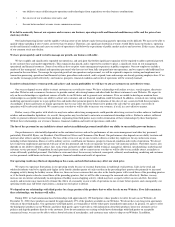Overstock.com 2002 Annual Report Download - page 21
Download and view the complete annual report
Please find page 21 of the 2002 Overstock.com annual report below. You can navigate through the pages in the report by either clicking on the pages listed below, or by using the keyword search tool below to find specific information within the annual report.
revenue recognition;
estimating valuation allowances and accrued liabilities, specifically, the reserve for returns and the allowance for obsolete and damaged
inventory;
accounting for income taxes; and
valuation of long-lived and intangible assets and goodwill.
Revenue recognition. We derive our revenue from three sources: (i) direct revenue, which consists of merchandise sales made to consumers and
businesses that are fulfilled from our warehouse; (ii) commission revenue, which consists of consumer commission revenue and B2B commission revenue
from the sale of merchandise owned by third parties; and (iii) warehouse revenue, which consists of sales of residual products from large bulk purchases of
inventory. Both direct revenue and commission revenue are recorded net of returns, coupons redeemed by customers, and other discounts. For commission
revenue, we only recognize the commission portion of the sale of merchandise owned by third parties, because we are acting as an agent in such transactions.
Significant management judgments and estimates must be made and used in connection with determining revenue recognized in any accounting period.
For sales transactions, we comply with the provisions of Staff Accounting Bulletin 101 "Revenue Recognition" which states that revenue should be
recognized when the following revenue recognition criteria are met: (1) persuasive evidence of an arrangement exists; (2) the product has been shipped and
the customer takes ownership and assumes the risk of loss; (3) the selling price is fixed or determinable; and (4) collection of the resulting receivable is
reasonably assured. We generally require payment by credit card at the point of sale. Any amounts received prior to when we ship the goods to customers are
deferred.
Reserve for returns and the allowance for obsolete and damaged inventory. Our management must make estimates of potential future product returns
related to current period revenue. Management analyzes historical returns, current economic trends and changes in customer demand and acceptance of our
products when evaluating the adequacy of the sales returns and other allowances in any accounting period. The reserve for returns was $465,000 as of
December 31, 2002.
Overstock writes down its inventory for estimated obsolescence or damage equal to the difference between the cost of inventory and the estimated
market value based upon assumptions about future demand and market conditions. If actual market conditions are less favorable than those projected by
management, additional inventory write-downs may be required. Our inventory balance was $14.0 million, net of allowance for obsolescence or damaged
inventory of $1.0 million as of December 31, 2002.
Accounting for income taxes. Significant management judgment is required in determining our provision for income taxes, our deferred tax assets and
liabilities and any valuation allowance recorded against our net deferred tax assets. As of December 31, 2002, we have recorded a full valuation allowance of
$21.6 million against our net deferred tax asset balance due to uncertainties related to our deferred tax assets as a result of our history of operating losses. The
valuation allowance is based on our estimates of taxable income by jurisdiction in which we operate and the period over which our deferred tax assets will be
recoverable. In the event that actual results differ from these estimates or we adjust these estimates in future periods, we may need to change the valuation
allowance, which could materially impact our financial position and results of operations.
Valuation of long-lived and intangible assets and goodwill. Effective January 1, 2002, we have adopted SFAS No. 142 Goodwill and Other Intangible
Assets. Under this standard, goodwill is no longer amortized, but must be tested for impairment at least annually. Other long-lived assets must also be
evaluated for impairment when management believes that an asset has experienced a decline in value that is other than temporary. Future adverse changes in
market conditions or poor operating results of underlying investments could result in losses or an inability to recover the carrying value of the asset that may
not be reflected in an asset's current carrying value, thereby possibly requiring an impairment charge in the future. There were no impairments of goodwill or
long-lived assets during 2000, 2001, or 2002. Net intangible assets, long-lived assets and goodwill amounted to $3.1 million as of December 31, 2002.
Results of Operations
The following table sets forth our results of operations expressed as a percentage of total revenue for 2000, 2001 and 2002.
Year ended December 31,
2000 2001 2002
(as a percentage of total revenue)
Direct revenue 85.3% 88.1% 84.9%
Commission revenue 3.4 9.9 13.5
Warehouse revenue 11.3 2.0 1.6
Total revenue 100.0 100.0 100.0
Cost of goods sold(1) 109.0 86.6 80.0
Gross profit (loss) (9.0) 13.4 20.0
Operating expenses:
Sales and marketing expenses(2) 44.6 14.5 9.4
General and administrative expenses(2) 29.6 23.6 11.8
Amortization of goodwill 0.9 7.6 —
•
•
•
•
























